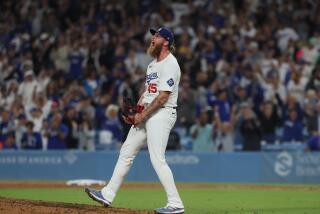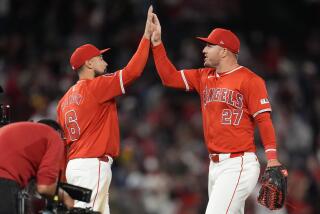Retooling Angels bullpen will take some fine craftsmanship
- Share via
This year marks the 10th anniversary of the Angels’ World Series championship, a club distinguished in part by a bullpen built more on hope than on money.
The closer was a converted catcher. The key setup guys were a September call-up not old enough to drink and two refugees from the independent leagues.
The Angels had no choice. That was the last year B.A. (Before Arte). The Angels did not spend even $1 million on their shortstop, let alone a middle reliever.
So, if progress means they can spend $5 million on a guy to pitch the seventh inning, why does their bullpen seem so much more unstable now?
“I wish I could tell you there was an element of rocket science to it,” General Manager Jerry Dipoto said. “There isn’t.”
The Angels have All-Star closer Jordan Walden and his 100-mph fastball, four veteran setup men with an average age of 38 and a combined salary of $13 million, and question marks every time Manager Mike Scioscia removes the starting pitcher.
This is not to say that the conventional sabermetric wisdom that veteran relievers are overpriced and overrated should apply to the Angels, or to any other big-money team. If you’re running a $150-million payroll, and that $5-million middle reliever might be marginally better than a replacement from the minor leagues, exercise your economic muscle and pay up.
But you look at the multiyear contracts the Angels have handed out to free-agent relievers in recent years, and you wonder. The busts include four years and $18 million to Justin Speier, two years and $17.5 million to Brian Fuentes, and two years and $11 million to Fernando Rodney.
“When you’re going out and trying to buy the back of your bullpen in the free-agent market, it’s a little bit of a game of Russian roulette,” Dipoto said.
The only insurance is not to play. Dipoto could not afford to play that game last year, when he and new Arizona Diamondbacks General Manager Kevin Towers set out to revamp what had been a pretty bad bullpen.
“One of the worst in history,” Dipoto said.
They imported a closer who had spent the previous year as a setup man, the year before that on the disabled list. They imported a setup man who had been a marginally successful swingman. They imported a left-handed specialist via the Rule 5 draft. They turned a double-A swingman into a short reliever and called him up in June.
The Diamondbacks made the playoffs. So did the financially challenged Tampa Bay Rays, despite losing each of the top six relievers from their 2010 American League East championship club.
The Dodgers started last season with 2010 All-Stars Jonathan Broxton and Hong-Chih Kuo at the back of their bullpen. They ended it with converted catcher Kenley Jansen in the eighth inning and Javy Guerra, summoned from his third consecutive year at double A, in the ninth inning.
The Angels do not have even that kind of organizational depth, at least for now.
When Bill Stoneman was the Angels general manager, he drew criticism from fans and rival executives for hoarding his prospects.
After Tony Reagins replaced Stoneman, the Angels gave up young pitchers — three to Arizona in the Dan Haren trade, two to Kansas City in the Alberto Callaspo trade, Alex Torres to Tampa Bay in the Scott Kazmir trade and Darren O’Day was claimed on waivers.
In addition, the Angels forfeited draft picks as compensation for signing free agents. In the last five years, they lost picks for signing Fuentes, Speier, fellow reliever Scott Downs and outfielders Torii Hunter and Gary Matthews Jr. They’ll lose their first two picks this year for signing Albert Pujols andC.J. Wilson.
As Stoneman and Scioscia transformed the Angels from perennial mediocrity into perennial contenders, pitching was the foundation, with live arms collected and nurtured. To the question of whether the pitching depth in Anaheim is as good now, Scioscia’s answer is direct.
“It’s not,” Scioscia said. “Sometimes, that’s the price you pay for achieving what we achieved the last 10 years.
“There’s only so much talent every organization has in the minor leagues. Our system has flourished for a long time. Right now, there are some voids.”
Dipoto is working cautiously to repair the relief corps. He patched some holes over the off-season, avoiding the expensive likes of Heath Bell, Ryan Madson and Jonathan Papelbon in favor of modest one-year contracts for 39-year-olds LaTroy Hawkins and Jason Isringhausen.
In the meantime, he is gently steering the Angels away from a bullpen dominated by right-handed power arms and toward a collection of arms with what he calls “different looks” — different arm angles, different out pitches, different velocities.
“You want to try to create as much diversity as you can,” he said.
To fans reading this far and waiting for the condemnation of this year’s Angels bullpen, or for Dipoto’s imminent plan to blow it up, sorry.
The Angels ranked second in the league last season in innings pitched among their starters, and second in earned-run average among their relievers. That is causation, not correlation.
Pujols steals the spotlight, but these Angels are built on the foundation of their front four. If Haren, Wilson, Jered Weaver and Ervin Santana cannot pitch into the seventh inning with regularity — and the quartet could not do so during the first two turns of the rotation — the bullpen will not be close to the biggest problem in Anaheim.
twitter.com/BillShaikin
More to Read
Go beyond the scoreboard
Get the latest on L.A.'s teams in the daily Sports Report newsletter.
You may occasionally receive promotional content from the Los Angeles Times.











